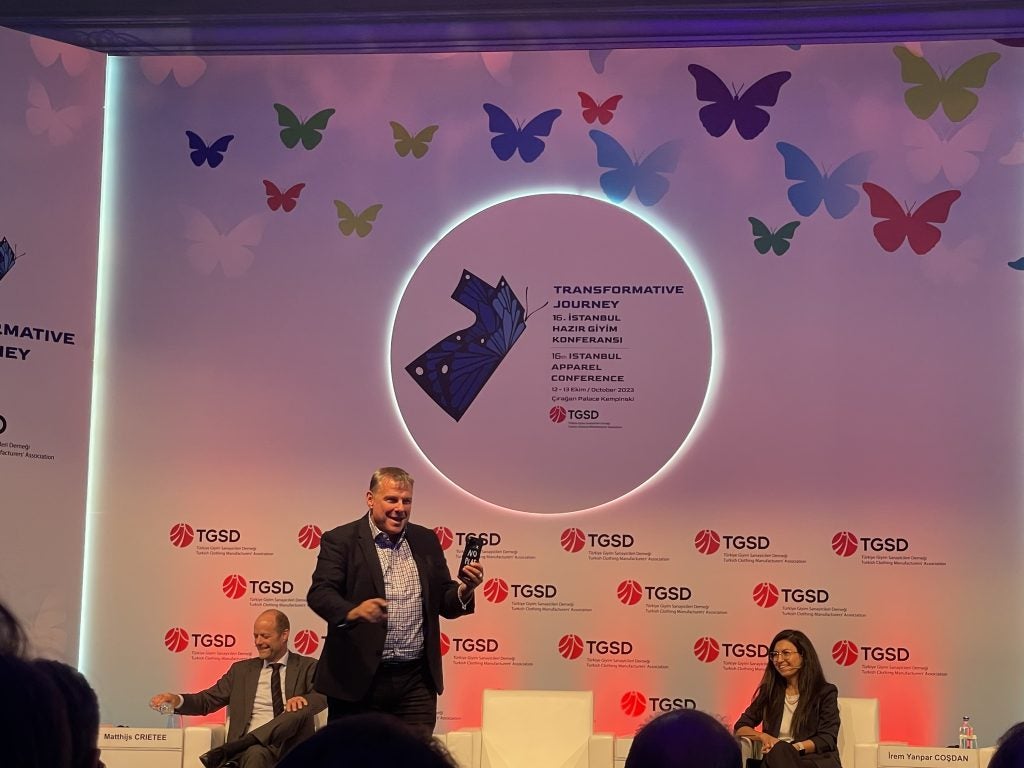While I make my way through the gigantic hall at the Çırağan Palace Kempinski in Istanbul, buzzing with conversations from apparel industry stakeholders, I soon run into the SAC's Andrew Martin where our discussion about the crucial role of Responsible Purchasing Practices in the apparel industry heats up.
Martin points out the "tsunami or hurricane" of regulations coming in, adding that it is important for these regulations to be aligned across different regulatory spaces.
He explains that even within the EU context there are directives versus actual regulations, creating confusion since they are often interpreted differently. "It doesn't help the industry," he asserts.
Bringing industry stakeholders in-line with regulations
Martin points out that the industry needs clarity on where it needs to go. He says SAC has been working in this arena by creating aligned frameworks for communication even before the regulations came into play. The industry already has tools, frameworks, alignments, but what remains is the "real drive" and "systemic change" in the form of regulation to support and guide it, he says.
For this, he believes it is important that all stakeholders across the value chain, especially manufacturers, have a representative voice and influence in guiding the regulation development. This becomes increasingly important because whether it is due diligence or designing products for circularity, the people who make the product need to be a part of this conversation.
He continues: "One thing I would say is if you have aligned regulation, I think it needs to be smart and implementable; that's one of the biggest issues. And that's where I think listening to the industry, but also listening to the whole value chain is really important, especially at an event like this."
But Martin is quick to note that the industry has a responsibility to make sure that the burden isn't just passed to the manufacturers. This is where regulation comes in, he says.
"I think regulation is an interesting space for brands and retailers to have conversations with manufacturers about how to work together in partnership to drive things forward."
He shares that the SAC is undertaking a deeper review of how the Higg Index Tools support its members with upcoming regulation such as the Corporate Sustainability Reporting Directive (CSRD), Corporate Sustainability Due Diligence Directive (CSDDD) and others.
"Crucial for us is that there is alignment and consistency on upcoming regulations and that they build on established industry protocols such as the OECD Due Diligence Guidance for Responsible Supply Chains in the Garment and Footwear Sector which has a focus throughout on Responsible Purchasing Practices and which was a key reference point for informing the latest Higg Index Brand & Retail Module (BRM)," adds Martin.
Responsible Purchasing Practice: A lever for driving change
Martin describes Responsible Purchase Practices as a thread and glue between all other pieces of the apparel industry, calling it a lever for driving systemic change. In simpler terms, Responsible Purchase Practice or RPP is based on the principle of a mutually beneficial relationship for both the brand and supplier.
The entire apparel industry, encompassing planning and forecasting to supplier relationships, payment terms, and penalties, relies on responsible purchasing practices.
He elaborates: "At SAC, we have potential influence because of our size and scope. We have three pillars, one on climate change which includes things like adopting renewable energy and material efficiency. The second one is on decent work, while the third one incorporates nature and talks about things like circular product design. But for all these pillars to work, we need responsible purchasing practices which acts like a lever for driving systemic change."
He argues that Responsible Purchasing Practice is often thought of only in the context of "social labour" but we forget other important questions like who is making the product? who is designing it? what is the environmental impact?
Adding to his argument, Martin says: "Currently, inequalities in textile and apparel supply chains are holding our industry back — we need more equitable apparel supply chains to unlock a fairer and stronger industry where everyone is treated with respect and dignity. Without responsible purchasing practices, suppliers are left in precarious financial positions, which can translate into poor working conditions for those on the factory floor and divert resources from essential investments to support decarbonisation and environmental improvements."
The way forward therefore, he believes, is based on the cornerstone of relationships, collaboration and action. The purchasing practice relationship between a brand and tier one suppliers goes on to tier two suppliers, then from tier two to tier three suppliers and so on. Unless brands and retailers focus on this relationship with their value chain, achieving something as basic as their science-based targets or lowering emissions will be a challenge.
It is evident that the road ahead necessitates a collective effort, where industry professionals, policymakers, and consumers must unite to demand responsible purchasing practices. As the fashion industry evolves, these practices must evolve too, laying the foundation for a sustainable, ethical, and equitable future.
He advises the industry to take examples from the frontrunners of what is possible and what can be done. Martin says: "I think we have got examples of best practice, how to work in partnership with suppliers. We have tools and solutions to deliver what's required which is why I think regulation becomes important. At the moment, it is only the frontrunners using these tools, whereas, the regulations can actually help focus all of that into accelerating the industry to where it needs to go."









